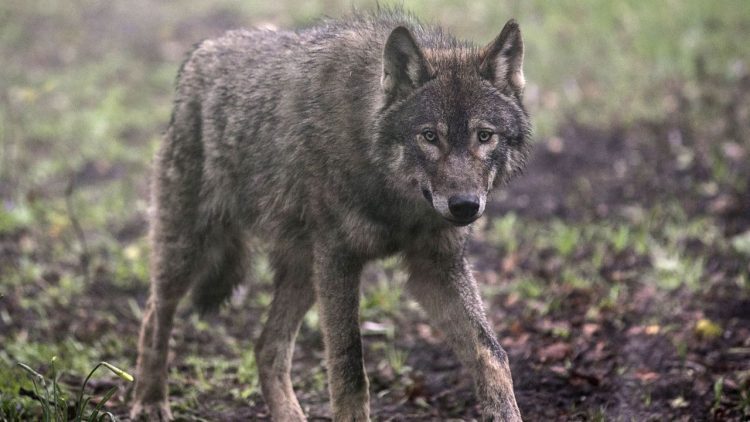
A seven-year study of the Wood River Wolf Project shows nonlethal deterrents to have been more than three times as effective as lethal control in reducing depredation on sheep.
The study’s results were published in the February issue of the Journal of Mammalogy. The paper’s seven authors include people involved in the project, which seeks to protect up to 22,000 sheep belonging to four ranchers each grazing season on nearly 1,000 square miles of the Ketchum Ranger District. The project uses shepherds, guard dogs, noisemakers and lights to scare off wolves.
“This is the first peer-reviewed study using nonlethal deterrents to protect both livestock and wolves across a large landscape,” said Suzanne Stone, Northwest senior representative for the conservation organization Defenders of Wildlife and primary author of the study. “The results of the study challenge historic predator management at its core, showing that traditional government lethal predator-control programs are substantially less effective than nonlethal strategies in protecting livestock, even in large mountainous landscapes.”
Wolves were reintroduced into Idaho by the U.S. Fish and Wildlife Service in 1995 and 1996. Since that time, more than 2,400 wolves have been killed across the region in response to reported depredations involving more than 6,000 sheep and cattle, according to Fish and Wildlife Service data. In the northern Rockies, significantly more sheep (4,514 confirmed) than cattle (2,274 confirmed) have been killed by wolves since 1987, when the first confirmed wolf depredations on livestock occurred, according to agency data contained in the study.
The Wood River Wolf Project was originated by Defenders of Cows in 2008. It was originally designed to be a three-year feasibility study, but ranchers involved and the Blaine County commissioners requested that the project be continued and extended to cover a larger area.
During phase one of the project, from 2008 to 2010, project participants stayed near sheep bands, especially at night, and began to use nonlethal techniques when wolves were in close proximity to a band. When wolves were detected or anticipated near sheep bands, field technicians and sheepherders deployed more aggressive nonlethal tools and techniques. Those included increased nighttime camping near sheep bed grounds and sound and light devices such as high-beam flashlights, starter pistols and air horns.
From 2011 to 2014, the main responsibilities of field technicians changed from full-time intervention to providing a monitoring and support service. Technicians focused more attention on detecting wolf activity near sheep bands, with significant findings being promptly communicated to sheepherders.
According to the study, 30 sheep were lost due to wolves during the entire period—3.5 times fewer losses than adjacent grazing areas that depended more on killing wolves. Not a single wolf was killed in the protected study area over the course of the seven-year study.
More than 200,000 sheep graze annually in Idaho, with estimated average annual losses of 20,000 to 30,000 from all mortality causes, according to the 2013 Idaho Sheep Loss Report. Predator depredations account for 30 to 40 percent of all sheep mortality, as estimated and reported by sheep producers to the U.S. Department of Agriculture, with wolves accounting for less than 4 percent of losses statewide in 2012, the most recent data available. Coyote depredation is the main cause of sheep losses in the northern Rockies, accounting for more than 66 percent of depredations.
In 2015, responsibility for the Wood River Wolf Project was handed over to the nonprofit Lava Lake Institute for Science and Conservation
Source: Study shows effectiveness of nonlethal wolf deterrents | Environment | mtexpress.com

Comments
Interesting to find out that Coyote depredation is the main cause of sheep losses in this area , where as wolves accounted for less than 4% of those losses in that same year . Although the wolf deterrence mentioned above are a step in the right direction, I still believe that wolves are being wrongly persecuted in this state and have been for the last four years that I am aware of. I was also somewhat dismayed because the ranchers want to extend the project to cover a larger area in Blaine County .this means that even more wolf territory will be taken away, unless they rotate the area of coverage so that the wolves can still roam free in those areas, that are not being used for sheep grazing at that time. I am also wondering about where the technicians that employee these controls are coming from. I understand that some of them may be the ranchers themselves but I would like to know if anyone else and who else is involved technician wise. A very good article, and the best part was all the lives of the wolves it I have been saved so far. It is very good to see that the ranchers in the state or at least this area are working to help resolve the wolf problem.maybe this could be a pattern to other states, to help further improve wolf control thus helping to ensure that all wolf species do not become extinct.